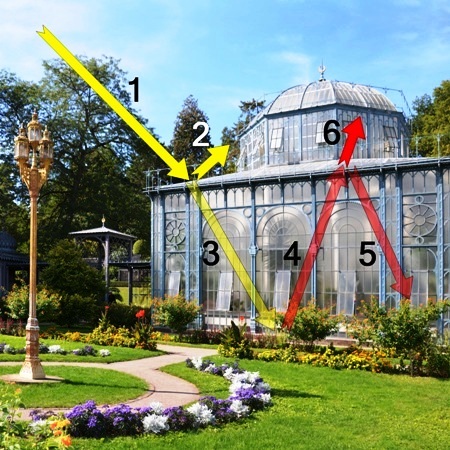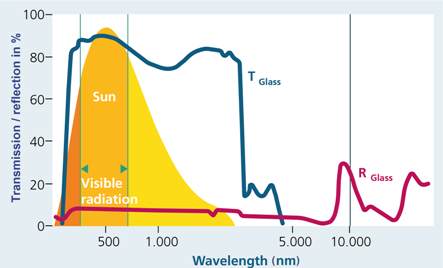3. Climate and climate change
The greenhouse effect (3/4)
The radiative balance
We had calculated the radiative power emanating from the sun that is absorbed by the Earth as black Earth and as blue planet. The starting point was the radiation temperature Trad,S = 5772 K of the photosphere. We had also found a relationship for the radiative power emitted by the Earth, where the value of the mean radiation temperature Trad,E of the Earth's surface remained open. This is the quantity we are looking for!
If we assume that the solar radiative power absorbed by the Earth is equal to the radiative power emitted by the Earth, we can determine the Earth's radiation temperature. We already know that this balance is not exactly fulfilled, which is why we have climate change, but the deviation is assumed to be relatively small. Equating absorbed solar radiation and radiation emitted by the Earth gives:
Black Earth:
This is the case with the highest possible absorption of the available solar radiation. Nevertheless, the mean temperature of the Earth is still 9°C lower than the actual mean value 14°C!
Blue Planet:
As we can expect, the temperature of the Earth, with its albedo corresponding to a 30% lower absorption of solar radiation, is even colder. It is so cold that liquid water would not be able to exist!
For comparison: during the last ice age 20 000 years ago, the mean temperature was about +8°C! Even the black Earth would be 3°C colder!
What is not taken into account in our model?
It is the greenhouse effect. It reduces the Earth's radiation loss into space so much that today, our biosphere has a very suitable mean temperature of 14°C.
The greenhouse effect is therefore absolutely essential for the Earth as we know it.
How does a greenhouse work?
The window glass of greenhouses allows solar radiation to pass through, but it blocks the infrared radiation produced inside at wavelengths higher than 3.5 μm. This explains the moderate temperatures in the greenhouse. The gain by solar radiation must be balanced by losses to obtain an energy balance, otherwise the temperatures inside should steadily get higher. This is done by heat conduction: the inner glass surface heated by absorption conducts heat to the outside. There is direct heat transfer to the air, which explains the loss of energy. In fact, windows are actually a strong source of heat leakage in buildings.

A greenhouse, Wilhelma Zoological-Botanical Garden Stuttgart, Germany. Incident (1), reflected (2), and solar radiation reaching the ground (3). Thermal radiation from the ground (4), back radiation (5) from the inside of the glass, and heat loss (6).
Source: Rainer Reuter, University of Oldenburg, Germany.

